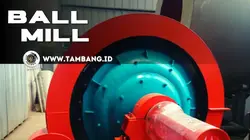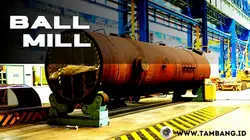021 - 7992- 077 info@tambang.id
Ballmill - Stone Refining Machine
Mengapa Memilih Jenis Ball Mill yang Tepat Sangat Penting
 |  |
|---|---|
 |  |
 |  |
 |
"A mining operation without a reliable milling process is like a car without wheels, it may look good, but it can't move forward. And like there are various types of wheels there are various types of ball mills. Not choosing the right one will teach you a very expensive lesson."
S. Leendertz
Ball mills are a crucial component in the mining industry used to grind ores and other materials into smaller, more manageable sizes. That's called sizing. There are several types of ball mills, each with their own unique set of characteristics and features. These need to be chosen carefully.
Feed Type: Continuous vs Batch
Continuous ball mills are used for continuous grinding, while batch ball mills are used for intermittent grinding.
Material Type: Wet vs. Dry
Wet ball mills are used to grind materials that contain water, while dry ball mills are used to grind materials that do not contain water.
Milling Media: Ceramics vs Steel
Ball mills can also be categorized based on the materials used for milling media. Ceramic ball mills use ceramic balls as the milling media, while steel ball mills use steel balls.
Lining: Mangan vs. Rubber
Linings for ball mills can also be made from a variety of materials, including rubber and manganese.
In summary, ball mills are a type of grinding machine used in mining to reduce the size of ores and other materials. They come in different types such as continuous, batch, wet and dry, and can use different materials as milling media and linings.
Determine which Ball mill is right for you.
There is a range of questions you would need to answer to be able to determine which type of ball mill suits your operations. And it is highly recommended not to skip those questions. Talk to us if you need assistance.
These are the questions you should ask yourself before buying a ballmill:
-
What is the material to be processed?
-
What is the materials hardness class?
-
What is the desired particle size of the final product?
-
What is the capacity (volume) of material to be processed?
-
Will the process be continuous or batch operation?
-
Will the milling process be wet or dry?
-
What type of liners will be used (if any)?
-
What type of milling media will be used (e.g. steel balls, ceramic balls)? If your output material is sensitive towards changes of iron content then you need to use ceramic balls for instance.
-
What are the safety and environmental requirements?
-
What are the space and power supply limitations?
-
Will the mill be used for primary or secondary grinding?
-
What is the feed size?
-
What is the discharge size?
-
What are the specific requirements for the application?
-
What is your process flow chart and what connectivity must you ball mill have?
Answering these questions will help to determine the most appropriate type of ball mill for the customer's specific needs and requirements.
Features & Key Advantage

customization

heavy duty

High Recovery

Full Service

German Quality
Consequences of picking the wrong type of ball mill.
Very common occurrence in Indonesia for instance. Picking the wrong ball mill happens way too often. It's one of the most common rookie mistakes. Procurement specialists not really understanding mining and metallurgy are especially prone to go wrong here. And it often costs them their job. Be diligent please.
Picking the wrong type of ball mill can have several consequences, including:
Reduced efficiency
Using a ball mill that is not well-suited for the specific application can result in reduced efficiency, as the mill may not be able to effectively grind the material to the desired size or consistency.
Increased downtime
If the ball mill is not able to handle the volume or type of material it is processing, it may break down more frequently, leading to increased downtime and maintenance costs.
Quality issues
Using the wrong type of ball mill can lead to poor product quality, as the material may not be properly ground or mixed.
Safety risks
If the ball mill is not designed or operated correctly, it can pose a safety risk to operators and maintenance staff, as well as the potential for fires or explosions.
Environmental issues
If the ball mill is not suitable for the specific application, it may not comply with environmental regulations, leading to fines or penalties.
Higher costs
If the ball mill is not capable of meeting the production needs, it can lead to increased costs for additional equipment or increased labor costs as a result of slower production rates.
Reduced production
If the ball mill is not able to handle the process, it can result in reduced production, which can lead to a loss of revenue.
ATM Promining™ Warranty
We are metal and gold processing experts. We are mining ourselves and hence provide a hands on perspective. Not a mere gear equipment supplier view.
We are an international team with diverse expertise covering metallurgy, engineering, mining and related knowledge. Our experience is an asset for our customers, leading to a very high level of success.
Since 20 years.
Experts Team.
Hands On Approach.
Full Support.
We manufacture.

Extensive know-how.